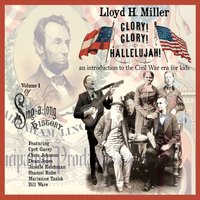If I told you that Lloyd Miller recorded an entire album about Civil War characters (in many meanings of that last word), you should not be surprised one bit. This most history-obsessed of kids musicians has been recording songs about the famous and the infamous and those who aren't known well enough to be either from almost the very beginning of his band The Deedle Deedle Dees.
But he's never been as focused on a single period as he is on his new solo album Glory! Glory! Hallelujah!, subtitled An Introduction to the Civil War Era for Kids. It's labeled as Volume 1 of Miller's new Sing-A-long History project, suggesting listeners will get to hear more deep dives into history, which plays into Miller's interest in hearing from all the personalities. One might expect a Civil War-based album to feature lots of songs about Lincoln, but the Great Emancipator is more of a side character -- aside from a setting of Walt Whitman's "O Captain! My Captain!" (a duet with Marianne Tasick) and a recording of the Gettysburg Address featuring more than a dozen folks, Lincoln doesn't really make an appearance.
Instead, the album is more interested in characters like Baldy, the horse of Union General George Meade, whose head is mounted on the wall in a Philadelphia Museum, who get a song ("Baldy") to themselves. (That one's an old Dees track, re-recorded here.) Or Harriet Jacobs, a slave who escaped from her master, but who lived "Trapped in the Attic" for seven years before making it safely to freedom in the north. (It's an awesome, urgent song.) "Weeksville" introduces listeners to one of the first free black communities in the United States, founded in Brooklyn before the Civil War. It's not that Miller isn't interested in the War itself -- John Brown makes an appearance, as do songs of the time like "Follow the Drinkin' Gourd," "Marching Through Georgia," and "Tenting on the Old Campground." But Miller would rather sing through the voices of the people whose voices haven't been drilled into our brain over the past 150 years, the slaves and soldiers (and, er, the horses), but use more modern sounds -- rock and hip-hop, for example -- to do so.
The 38-minute album will be most appropriate for listeners ages 7 and up. You can listen to four tracks from the album here. I also recommend the curriculum guide (a first draft can be downloaded here), which features lyrics, historical background, and suggestions for classroom activities and further reading.
Because of its slightly narrow focus, Glory! Glory! Hallelujah! won't be to everyone's tastes, certainly all the time. But Miller gets credit for introducing the familiar big picture story of the Civil War through newer, less familiar lenses. His enthusiasm for the material shines through, giving new voices to old voices, which lifts this above many educational albums in terms of appropriateness in a broader context (e.g., the minivan). Highly recommended for the classroom setting, but recommended for all.
Note: I was provided a copy of the album for possible review.









